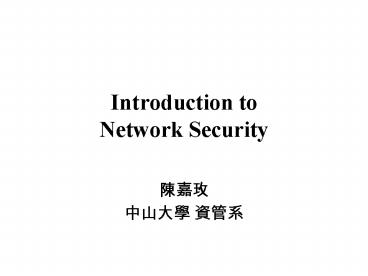Introduction to Network Security - PowerPoint PPT Presentation
1 / 31
Title:
Introduction to Network Security
Description:
as strong as the encryption algo. random number generator. Attacks against implementation ... DES encryption algo. IDEA encryption algo. Triple DES ... – PowerPoint PPT presentation
Number of Views:51
Avg rating:3.0/5.0
Title: Introduction to Network Security
1
Introduction to Network Security
- ???
- ???? ???
2
Why Need Security?
- Computers store a wide range of information --
medical, credit card, or financial data - Computer networks get popular
- Misuse computer systems or alter the data.
3
Why secure a computer/network is hard?
- Error-free software?
- Security is added/considered at late stage.
- Security add-on cost.
- People who use/administer the system/network do
not follow security guidelines. - Social engineering
4
Security Plan
- To define your security needs
- Understands potential attackers
- Provides the security services
- Determine the level of security needed
- Find out the vulnerabilities
5
Security Attack
- Categories
- interruption -- attack on availability
- interception -- attack on confidentiality
- modification -- attack on integrity
- fabrication -- attack in authentication
- Passive attack
- eavesdropping
- monitoring
- transmission
- Active attack
- modification of message
- masquerade
- replay
- denial of service
6
(No Transcript)
7
Attacking Classification
- Attacks against design
- as strong as the encryption algo
- random number generator
- Attacks against implementation
- Attacks against hardware
- Attacks against trust models
- Attacks on users
- Attacks against failure recovery
- default to insure mode
- version rollback attack
- upgrade without shutting down
- Attacks against cryptography
8
Security Services
- Confidentiality
- Integrity
- Availability
- Authentication
- Authorization
- Non-repudiation
9
Tasks for Designing of a security service
- Design an algorithm for performing
security-related transformation - Create secret info used with the algorithm
- Develop methods for distribution and sharing
secret info. - Specify a protocol for two parties
- model from Fig 1-3
10
(No Transcript)
11
Network Access Security Model
- Information access threats
- intercept/modify data
- Service threats
- exploit service flaws
- Cases that not fit in model in Fig 1-3
12
(No Transcript)
13
Cryptography
- Classified in 3 dimensions
- type of operations used for transformation
- substitution
- transposition
- number of keys used
- way in which the plaintext processed
- block cipher on blocks (normally 64 bits) of
plain or cipher text - stream cipher convert the plaintext one bit at
a time.
14
Cryptanalysis
- ciphertex-only- attack
- the most difficult for cryptanalysis
- the easiest to defend
- unconditionally secure
- ciphertext not contain enough info to uniquely
determine plaintext - one-time pad
- computational secure
- cost of breaking cipher gt informations value
- time for breaking gt informations lifetime
- Next table gt DES not computational secure
15
Avg time for Exhaustive search
16
Steganography
- Plaintext can be hidden by
- Steganoraphy conceal existence of message
- cryptography
- Table 2.3
- Techniques of steganography
- Character marking
- Invisible ink
- Pin punctures
- Typewrite correction ribbon
- Drawbacks
- Large overhead
- Worthless if discovered
17
Conventional encryption
- Data Encryption Standard (DES), 1977, NIST
- Encrypt data in 64 bit blocks with 56 bit key
- International Data Encryption Algorithm (IDEA),
Swiss Federal Institute of Techonolgy, 1990 - Replace DES
- Encrypt data in 64 bit blocks with 128-bit key
- Strength
- Block length
- Key length
- Confusion
- Diffusion
18
DES encryption algo
19
IDEA encryption algo
20
Triple DES
- Encrypt-decrypt-encrypt (EDE) sequence with two
keys. - E with k1, then D with k2, and then E with k1.
- Is the more times the block encrypted, the more
secure it is? - Encryption twice with the same key is not more
secure than single encryption. - Double encryption (encryption twice with two
keys) is not as secure as encryption using a
double-len secret key. - Meet-in-the-middle attack
21
Substitution Techniques
- Replace each char with another char.
- Caesar Cipher
- Replace each letter with one three to the right
in alphabetical order. - A -gt D, B -gt E, and so on.
- ROT13
- Used by some UNIX systems.
- Replace each letter with one 13 to the right in
alphabetical order. - Same transformation function for both encryption
and decryption. - Substitution Cipher Variations
- Random sequence order of letters.
- Some letters are more frequently used than
others. - Vigenere Ciphers
- To break up the natural frequency of occurrence
for letters and groups of letters. - Change the substitution key during the message.
22
Transposition Ciphers
- Change the order in which the letters appear in
the message. - Won si eht emit rof lla doog nem
- Use various geometric patterns to transcribe the
message. - Nowis
- theti
- mefor
- allgo
- odmen
- Spiral pattern in a counter-clockwise direction.
- Ntmaodmenorisiwohellgotef
23
Encrypting a Large Message
- 4 Modes of operation
- EBC (Electronic Code Book)
- CBC (Cipher Block Chaining)
- CFB (Cipher Feedback)
- OFB (Output Feedback )
24
EBC Electronic Code Book
- Seeing the ciphertext can gain information from
repeated blocks. - Someone can rearrange blocks or modify blocks to
his own advantages. - Rarely used.
25
EBC
26
CBC Cipher Block Chaining
- Plain block i1 XOR cipher block Ci.
- A randomly chosen IV (initialization vector)
guarantees ciphertext will be different each time
even if the same msg is sent repeatedly. - Use message digest to prevent attack.
27
CBC
28
OFB Output Feedback
- Like a pseudorandom number generator (one-time
pad). - cleartext XOR pseudorandom number ? ciphertext.
- one-time pad can created in advance.
- j-bit OFB
29
OFB
30
CFB Cipher Feedback
- Similar to OFB, except shifting j-bits of
ciphertext. - One-time pad cannot be generated in advance.
31
CFB































